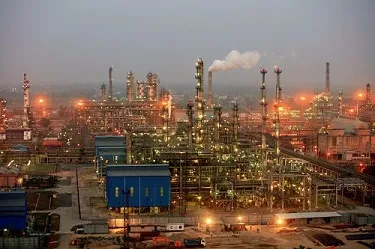Is India’s Energy Sector Thriving Amid Global Uncertainty?

Synopsis
Key Takeaways
- India's oil refining capacity has surged to 258 million metric tonnes per annum.
- Significant reforms in the upstream oil & gas sector have been enacted.
- 2.5 lakh square kilometers have been unlocked for exploration.
- ONGC and OIL are pioneering drilling in the Andaman ultra-deepwater region.
- 172 hydrocarbon discoveries since 2015 highlight India's potential.
New Delhi, Aug 10 (NationPress) Petroleum and Natural Gas Minister Hardeep Singh Puri stated on Sunday that India’s energy sector is thriving amidst global uncertainty, thanks to the reforms implemented in the oil and gas industry.
He remarked, "As the world grapples with fuel instability, India continues to advance with reforms. The country's oil refining capacity has risen from 215 to 258 million metric tonnes per annum (MMTPA), positioning Jamnagar as Asia’s largest refinery, exporting petroleum products to over 100 nations," as per his post on X.
Focusing on reforms in the upstream oil & gas exploration and production sector, the minister noted that the Open Acreage Licensing Policy (OALP) Round 10 has opened up 2.5 lakh square kilometers for exploration and production. Additionally, the number of clearances required for exploration has been halved from 37 to just 18, promoting an easier business environment.
According to him, "Prime Minister Narendra Modi’s vision is enhancing India’s energy security through resilience, with more than $1.3 billion invested in the upstream sector to boost oil exploration and production." He also mentioned in Parliament that India is experiencing a revitalized surge in oil and gas exploration, having opened nearly one million square kilometers of previously designated 'No-Go' offshore areas in 2022.
Since 2015, Exploration and Production (E&P) companies in India have reported 172 hydrocarbon discoveries, including 62 offshore. Puri emphasized the geological importance of the AN basin, situated at the convergence of the Andaman and Nicobar Basins within the Bengal-Arakan sedimentary system.
The tectonic situation, located at the boundary of the Indian and Burmese plates, has resulted in the formation of numerous stratigraphic traps conducive to hydrocarbon accumulation. This geological potential is enhanced by the basin's proximity to established petroleum systems in Myanmar and North Sumatra, attracting renewed global interest after significant gas discoveries in South Andaman offshore Indonesia, as explained by the minister.
In a noteworthy development, ONGC and Oil India Ltd (OIL) have initiated an ambitious exploration project in the Andaman ultra-deepwater region. For the first time, drilling operations are targeting depths of up to 5,000 meters. One wildcat well, ANDW-7, drilled in a carbonate play in the East Andaman Back Arc region, has provided promising geological insights, including traces of light crude and condensate in cutting samples, and heavy hydrocarbons like C-5 neo-pentane in trip gases.
These discoveries confirm, for the first time, the presence of an active thermogenic petroleum system in the region, similar to those in Myanmar and North Sumatra. While commercial reserves are yet to be established, this initiative has validated the existence of a working petroleum system and set the groundwork for focused exploration in the area, according to the minister.
Summarizing the exploration results, the Minister stated that ONGC has discovered hydrocarbons in 20 blocks, with estimated reserves of 75 million metric tonnes of oil equivalent (MMTOE). Meanwhile, Oil India Ltd. has reported seven oil and gas discoveries over the past four years, with reserves approximated at 9.8 million barrels of oil and 2,706.3 million standard cubic meters of gas.









